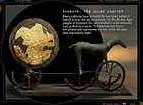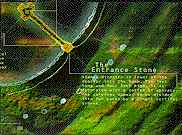
Multimedia WWW site.
| The Journal for MultiMediaHistory Volume 1 Number 1 ~ Fall 1998 |
Starsites: Celestial Navigation. Vancouver, Canada: DNA Multimedia, 1996. CD-ROM. PC and Macintish. [Detailed technical information is available at the DNA Multimedia Web site: http://www.dna.bc.ca/main.html.]
 |
Multimedia WWW site. |
The work explicitly uses the structural form of a hub to organize and move through its material. On its navigation page, four nested, concentric rings are cut, like a pie, into five wedges; the rings simultaneously point to, and act as a repository for, different levels of engagement with architectural environments, while the pie-like segments hold all the material relating to a particular architectural site. Beginning at the center of the hub, users can move out from the general (geographic information) to the specific (often these are distinct material elements of a site, such as ceremonial clothing, carvings, or associated ritual practices).
 |
Source: DNA Multimedia WWW site. |
The more general segments use a relatively uniform visual and graphic vocabulary. The introductions on the first level all use the same visual narrative structure, the second level maps use the same graphic and aural vocabulary, and the third level segments follow a rather standard narrative script pattern; voice-over accompanied by a series of static images. The more specific levels (some sites include a fifth ring not portrayed on the hub/map) use a more diverse set of structures, including games and game-like environments. The games come across awkwardly, however. Their frivolous feel is at odds with the pious gravity that hangs over the rest of the CD-ROM, instilled by such devices as new-age percussive/jungle/"exotic" background soundtracks, solemn voices reading the spoken word segments, and the consistently laudatory presentation of sites and the cultures that built them.
It is unfortunate that the often superficial and mundane quality of the descriptive texts, as well as the hub-dominated syntax by which the work is structurally ordered, means that StarSites is significantly less engaging�both intellectually and structurally�than a generic science museum exhibit. It is unfortunate because much of the graphic images that illustrate the work�the bird�s-eye maps of the sites, and the documenting photographs of specific elements in the sites�are strong and beautiful. But these successes are offset by two weaknesses. First is the architectural structure�s static and heavy-handed presence, which mitigates against the kind of intriguing or provocative narrative production that only CD-ROMs can provide. The work never asks real questions, and thus never produces the kinds of tensions that draw the user to explore investigative paths. Second is the homogenizing effect of the urge to demonstrate and valorize human universals, which obliterates any of the potentially intriguing specificities that might be at work in any one site.
Lastly, intelligent interactivity is hampered by the fact that the cursor does not consistently interact with responsive areas to tell a user that they can make something happen, actually encouraging, at times, wild clicking simply to determine if there�s anything out there to engage with.
Corinna Snyder
Wiley Technologies
![]() Comments
to: [email protected]
Comments
to: [email protected]
Contents: JMMH, Volume 1 Number 1 ~ Fall 1998